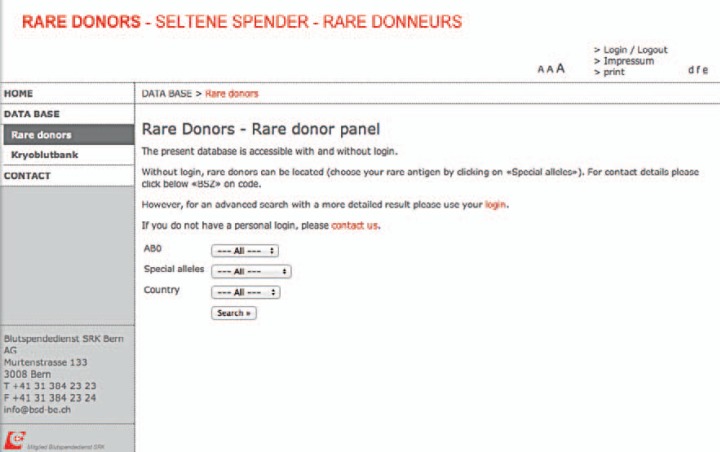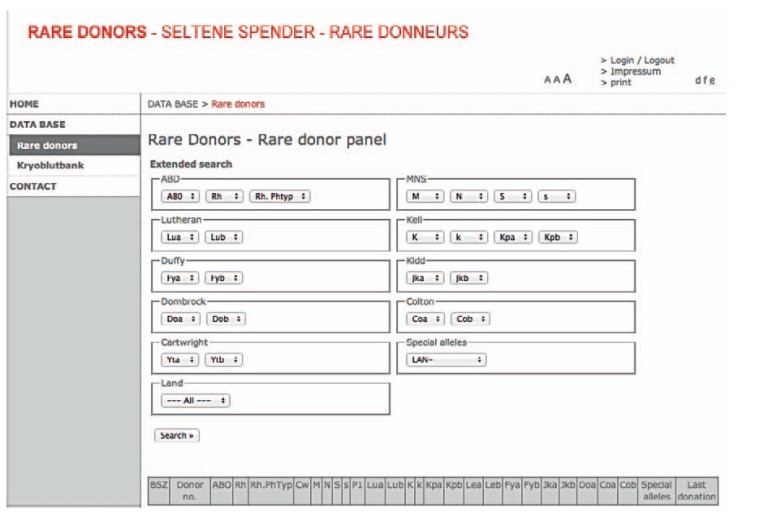Summary
For patients with antibodies against the most common blood groups a rapid and efficient supply of compatible erythrocyte concentrates is self-evident. But typically we have to make the greatest effort providing blood for these patients, which have made antibodies against common blood groups. There are however patients with antibodies against rare blood group antigens that need special blood. The supply of such blood can be very difficult and mostly time-consuming. For this reason we set up a database of blood donors with rare blood groups. Since 2005 the BTS SRC Berne Ltd. has run this database on behalf of the Swiss BTS SRC. After a reorganization and extension of the database, conducted during 2011/2012, the data file was renamed ‘DGTI Register of Rare Donors’ and is now run under the patronage of the German Society for Transfusion Medicine and Immunohematology (DGTI).
Keywords: DGTI, ISBT, Rare donor, Rare blood groups, Antigen, Phenotype, Bank of frozen blood, Database, Blood group genotyping
Introduction
The description ‘rare’ is not a fixed variable and can vary from country to country. For example, the phenotype Fy(a–b–) is extremely rare among Caucasians, but is found in up to 68% [1] of subjects of African origin. Generally speaking, the term ‘rare’ is used to refer to the absence of the highly common antigens such as Kp(b), Vel, P, Jr(a) and Lan (less than 1 in 1,000 donors) or for the very rare phenotypes Ko (Knull), Lu(a–b–), Jk(a–b–), Bombay and Rhnull. Other antigens, such as k–, Yt(a–), Co(a)– and Lu(b–) are slightly more common (1:350 to 1:700) and are also recorded in the DGTI Register. However, a k– donor with the phenotype O CCD.ee(R1R1) and who is Fy(a)– occurs only with a frequency of 1:5,000 to 1: 10,000!
Patients with rare blood groups or phenotypes are usually discovered following the formation of alloantibodies [2]. Since they need blood products from donors with rare blood groups (patients rarely become donors), managing such patients usually poses a major challenge. Ensuring that supply with these blood products can be guaranteed for patients quickly and efficiently requires, on the one hand, national and international databases of donors with rare blood groups and, on the other, a stock of frozen blood products. To this end, blood transfusion services worldwide work closely together in the ‘Rare Donor’ working party of the German Society for Transfusion Medicine and Immunohematology (Deutsche Gesellschaft für Transfusionsmedizin und Immunhämatologie; DGTI) or in the ‘Working Party on Rare Donors’ of the International Society of Blood Transfusion (the ISBT rare blood donor program) [3, 4].
Also very important is the cooperation with the blood banks in Amsterdam (Sanquin, Bank of Frozen Blood), Bristol (IBGRL; The International Blood Group Reference Laboratory) and Paris (INTS; Institute National de la Transfusion Sanguine), which stock fresh and frozen rare blood products. These blood banks are also served with rare blood from blood banks, not keeping frozen blood themselves.
How Are Blood Products Obtained from Donors with Rare Blood Groups?
The serological testing of a large number of blood donors is very time-consuming and costly. In recent years, the search for such donors has been intensified and revolutionized by the use of techniques such as PCR. Molecular blood group screening can be used to test large numbers of donors economically for numerous rare blood group alleles, including KEL*02 (k), KEL*04 (Kp(b)), YT*01 (Yt(a)), CO*01 (Co(a)), LU*02 (Lu(b)) and, as of last year, also VEL (Vel) and JR*01 (Jr(a)). This has already been implemented in various European countries (e.g. in Germany (Springe), Austria (Vienna) and Switzerland (Berne and Zurich)).
Unfortunately, it is not always meaningful to screen for every rare blood group. Examples are the blood group Oh (Bombay), the phenotype Rhnull (–/–) and the phenotype Knull, which are extremely rare. Example: a patient with the O blood group and anti-Ku antibodies requires Knull blood. In all the available databases there are currently only 4 entries (3 entries with 4 frozen units), and donors only exist in Japan with a total of 17 frozen units of packed red cells. This is a very bad scenario for a patient needing blood at regular intervals.
However, with most molecular blood group screening programs about 97% of the clinically important blood groups can be covered.
History of the Rare Donor File
In 1989, the former Blood Transfusion Service Swiss Red Cross (BTS SRC) in Switzerland approved a pilot project for setting up a frozen blood bank in Berne. However, the evaluation of the pilot project showed that the cost-benefit ratio was very poor, i.e. one blood unit of packed red cells would cost approximately CHF 15,000 to 20,000. It was therefore decided that the provision of rare blood products would need to be covered by ‘contactable donors’ and by cooperation with other countries.
The first version of an electronic database on the internet went live in 2002. This file did not have a search function, but was password-protected. In the same year the BTS SRC Switzerland decided that all regional blood transfusion services (RBTSs) in Switzerland should take part in this development. Since then these 13 RBTSs have supplied updated data three times a year. In Berne, all donors with a rare blood group are provided with an ‘L’ (= laboratory) code in the computer system. The units of these donors are available in the laboratory up to 1 week before expiry.
The first meeting of the ‘DGTI-Wide Register’ working party took place in November 2009. The participants at this meeting decided that the Bernese database should be upgraded.
Over the following 1.5 years, the new database was developed in Berne in collaboration with Dr. von Zabern, Dr. Deitenbeck, Dr. Burckhardt and Dr. Wagner. The costs were paid by the participating BTSs. This new database has been implemented in Switzerland in April 2011, and entries have also been received from Germany and Austria since January 2012. On September 1, 2012, the database was renamed: DGTI Register of ‘Rare Donors’ [5].
Database Address and Procedure
Currently, more than 700 blood donors are registered in the database. Table 1 gives an overview on the blood group specificities and the country of registration. The database can be accessed via www.bsd-be.ch/rare donors or directly on http://raredonor.bsd-be.ch. Alternatively, there is the German website www.seltene-blutgruppen.de, which also displays the logo of the BTS SRC Berne: this serves as a link to the ‘DGTI Register of Rare Blood Donors’. The language of the database can be changed from German to English or French.
Table 1.
DGTI Rare Donor Bank
| As at May 8, 2014 | Switzerland | Germany | Austria |
|---|---|---|---|
| –D– | 2 | ||
| CCddee | 21 | 4 | 13 |
| ccddEE | 10 | 8 | 4 |
| CCDDEE | 2 | 2 | |
| Coa– | 42 | 17 | 7 |
| CwCw | 7 | ||
| Fy(a–b–) | 85 | 7 | |
| Ge– | |||
| hh(Bombay) | |||
| IgA deficient | 14 | ||
| Jk(a–b–) | 42 | ||
| Jra- | 2 | ||
| k- | 158 | no entries | 44 |
| K-11 | |||
| Knull(K0) | |||
| Kpb– | 20 | 4 | 2 |
| Kx– | 2 | ||
| LAN- | |||
| Lu(a–b–) | 5 | 4 | |
| Lu(b–) | 65 | 34 | 8 |
| Lu-8 | |||
| Pk | 1 | ||
| pp | 3 | ||
| RH32, −46 | 1 | ||
| Rhnull | |||
| U-S-s- | 1 | ||
| UvarS-s- | 2 | ||
| Vel– | 28 | 6 | |
| Yta– | 50 | 27 | 36 |
Three options are available for accessing the database:
Without login (fig. 1): For initial guidance, the simple search function can be used without a password to see whether the desired ABO blood group in combination with the desired particular antigen (e.g. Vel–) exists at all in the register. All donors can be searched, but their details cannot be viewed. By clicking on the blood transfusion center, the relevant contact details appear. The details of frozen packed red blood cells stored in the Hagen German Red Cross center, the Munich and Ulm Institutes in Germany and the Vienna Institute in Austria can also be viewed.
Fig. 1.
Accessing the Register of Rare Donors without login.
With login (fig. 2): If you have obtained an indication of a potentially suitable donor, you can then view further details via a more complex password-protected search function: this retrieves a layout showing the most important blood groups in terms of transfusion medicine, in addition to the rare antigen and the donor number. Here too, clicking on the selected donor shows the contact details. The necessary password can be obtained from hein.hustinx @ bsd-be.ch.
Fig. 2.
Accessing the Register of Rare Donors without login.
With login for data entry (backend): If you are a representative of a blood transfusion service wishing to enter donors in the database, you can obtain special access by contacting hein.hustinx @ bsd-be.ch. The DE (Germany) database is structured in such a way that the individual centers/institutions are only able to supplement or modify their own data.
Disclosure Statement
The author declared no conflict of interest
Erratum
In the article
Arbach O, Funck R, Seibt F, Salama A: Erythropoietin may improve anemia in patients with autoimmune hemolytic anemia associated with reticulocytopenia. Transfus Med Hemother 2012;39:221–223.
figure 1 and figure 2 were interchanged. Figure 1 represents the data from case no. II and vice versa figure 2 represents the data from case no. I.
References
- 1.Reid ME, Lomas-Francis C, Olsson M. The Blood Group Antigen Facts Book. 3rd ed. New York: Academic Press; 2012. [Google Scholar]
- 2.Seltsam A, Wagner FF, Salama A, Flegel WA. Antibodies to high-frequency antigens may decrease the quality of transfusion support: an observational study. Transfusion. 2003;43:1563–1566. doi: 10.1046/j.1537-2995.2003.00565.x. [DOI] [PubMed] [Google Scholar]
- 3.DGTI Sektion Immunhämatologie-Gentechnik. Arbeitsgruppe seltene Blutgruppen. www.uni-ulmde/ wflegel/RARE/ (last accessed July 24, 2014).
- 4.Immunohematology. 2004;20(4) http://www.redcross.org/images/MEDIA_CustomProductCatalog/m16141441_20_4_04.pdf (last accessed July 24, 2014). [Google Scholar]
- 5.Hustinx H, von Zabern I. DGTI-Register seltene Spender. Transfusionsmedizin. 2013;3:82–84. [Google Scholar]




